
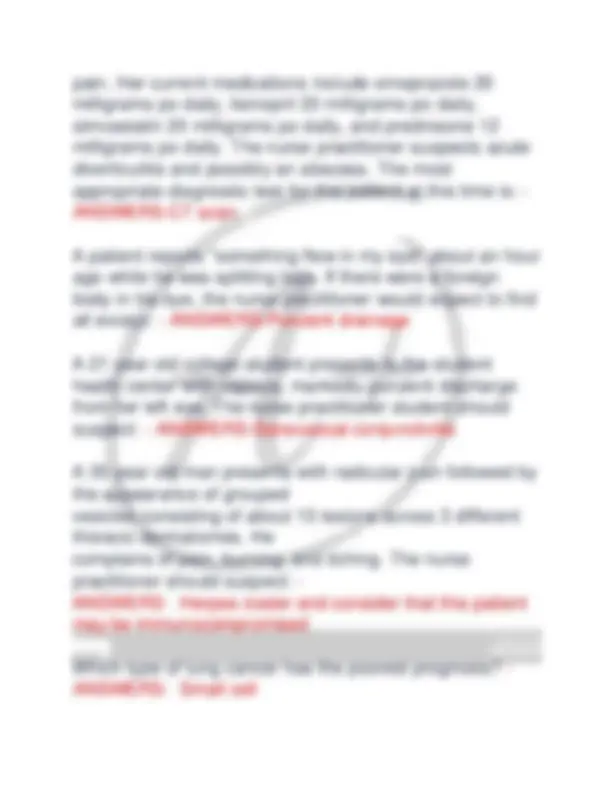
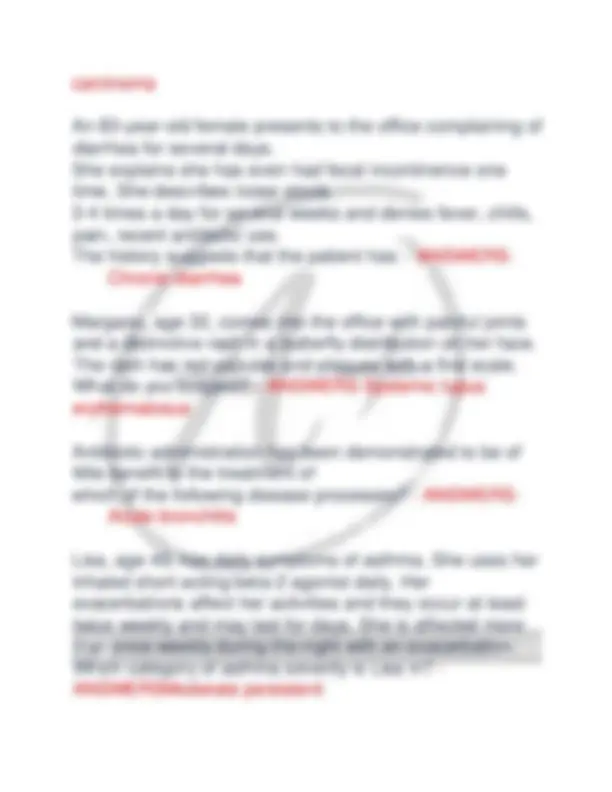
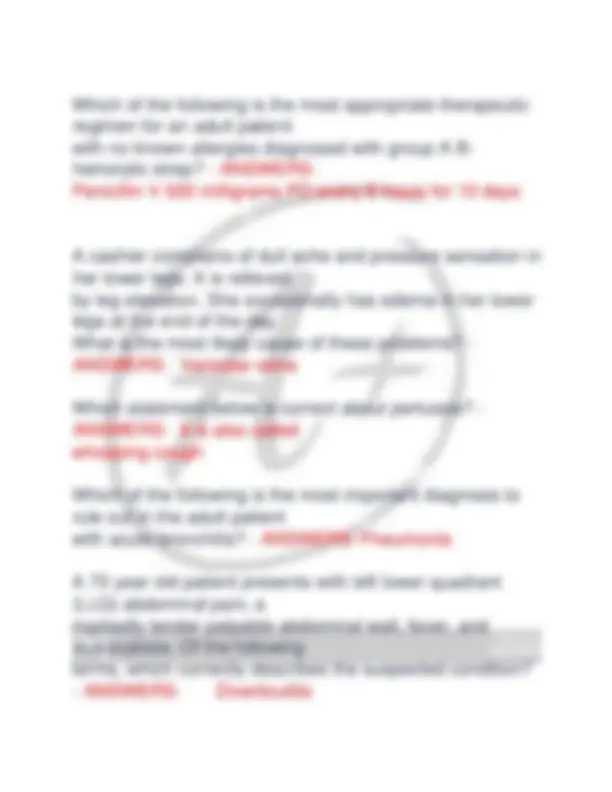
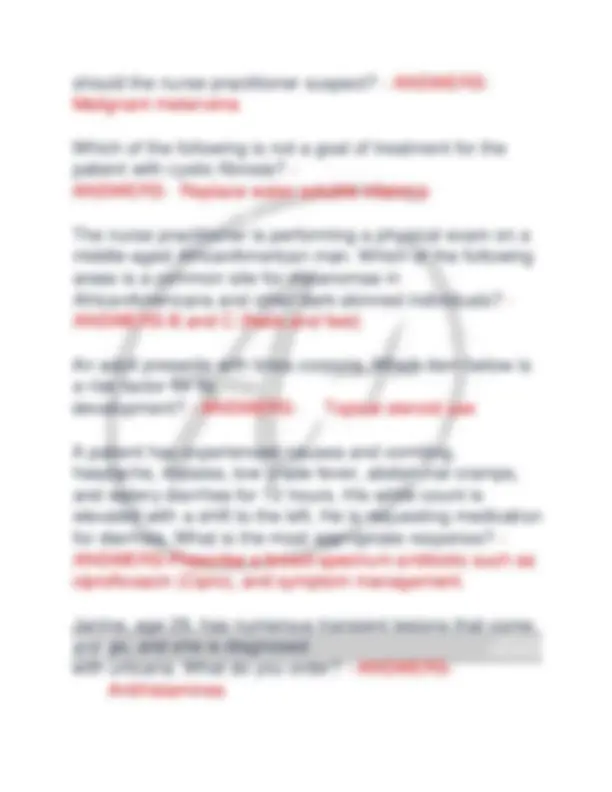
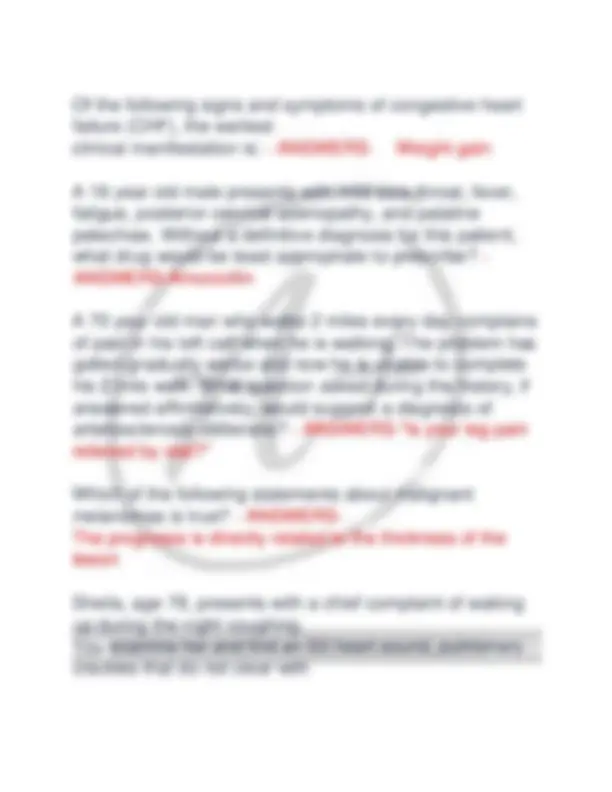
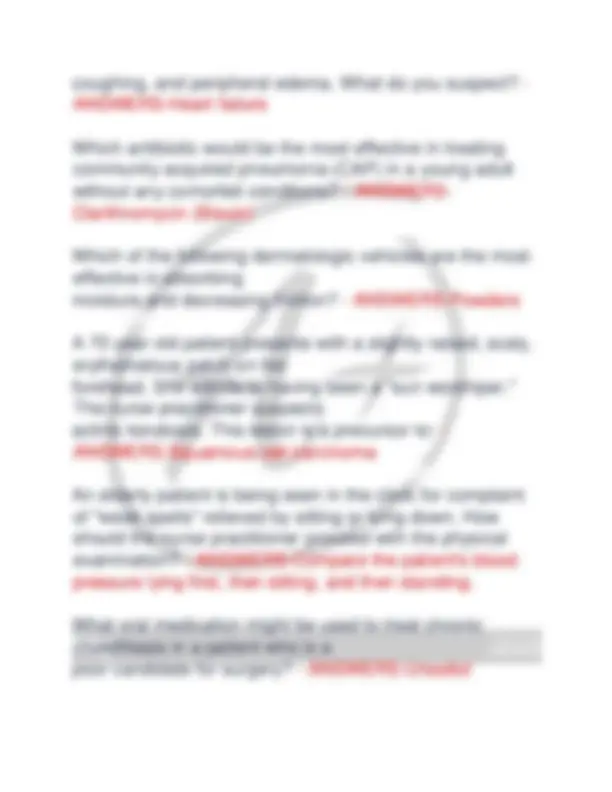
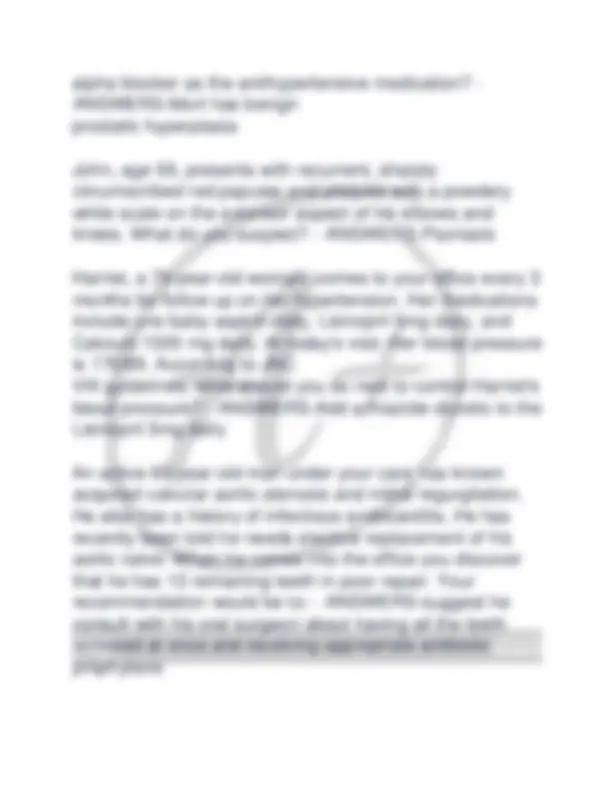
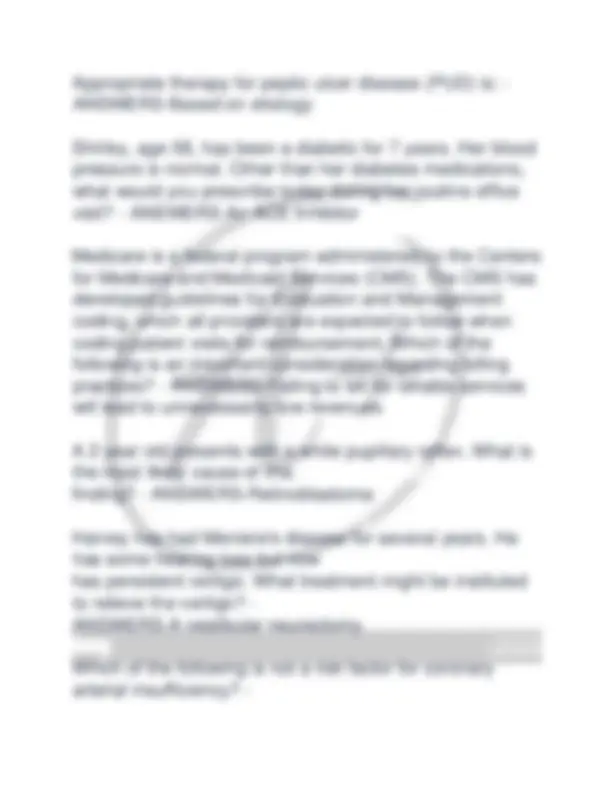
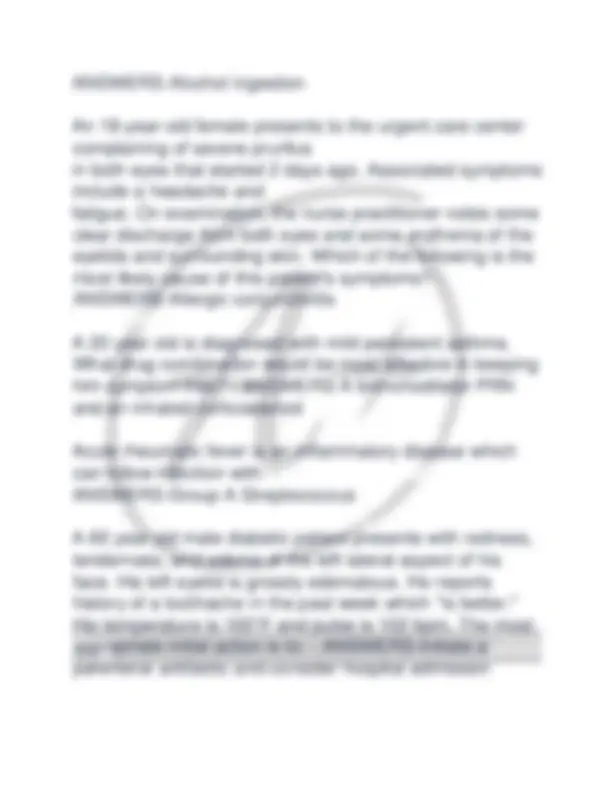

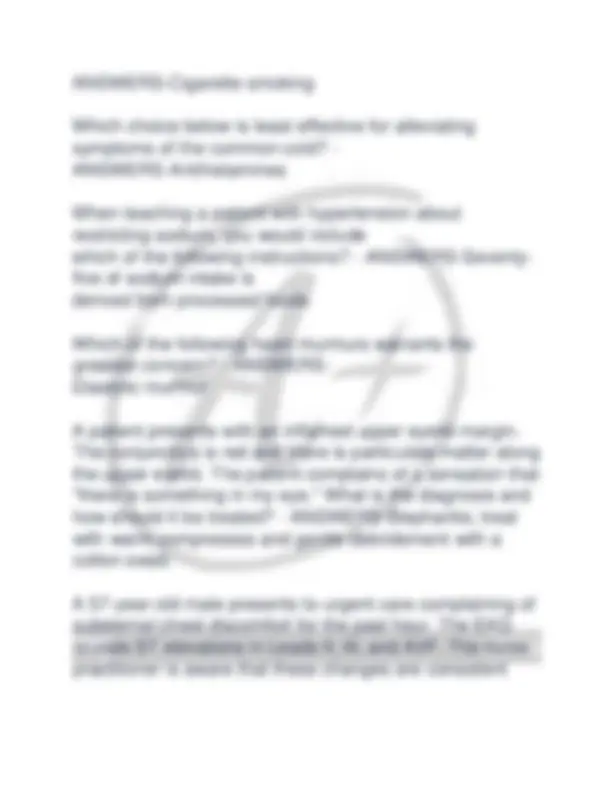
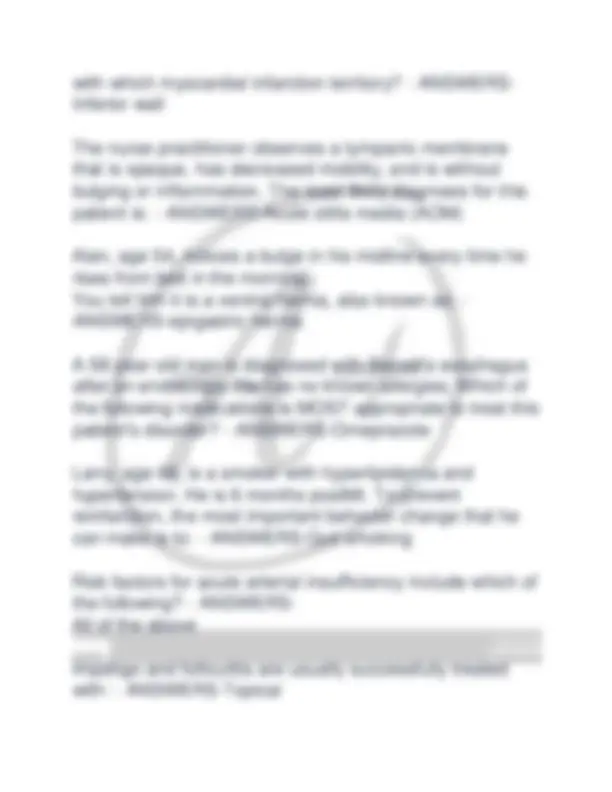



Study with the several resources on Docsity

Earn points by helping other students or get them with a premium plan


Prepare for your exams
Study with the several resources on Docsity

Earn points to download
Earn points by helping other students or get them with a premium plan
Community
Ask the community for help and clear up your study doubts
Discover the best universities in your country according to Docsity users
Free resources
Download our free guides on studying techniques, anxiety management strategies, and thesis advice from Docsity tutors
NRNP 6531 Midterm Exam 2025-2026 | Actual Exam Questions and Correct Answers| Rated A+
Typology: Exams
1 / 21

This page cannot be seen from the preview
Don't miss anything!














A 4 6 - year-old female with a past medical history of diabetes presents with a swollen, erythematous right auricle and is diagnosed with malignant otitis externa. The nurse practitioner knows that the most likely causative organism for this patient's problem is: - ANSWERS-Pseudomonas aeruginosa Which of the following is not a symptom of irritable bowel syndrome? - ANSWERS- Weight loss
A patient comes in complaining of 1 week of pain in the posterior neck with difficulty turning the head to the right. What additional history is needed? - ANSWERS-Any recent trauma The most common cancer found on the auricle is: - ANSWERS- Basal cell carcinoma Which of the following medication classes should be avoided in patients with acute or chronic bronchitis because it will contribute to ventilation- perfusion mismatch in the patient? - ANSWERS - Antihistimines A 47 year old male patient presents to the clinic with a single episode of a moderate amount of bright red rectal bleeding. On examination, external hemorrhoids are noted. How should the nurse practitioner proceed? - ANSWERS- Refer the patient for a barium enema and sigmoidoscopy. Which of the following patient characteristics are associated with chronic bronchitis? - ANSWERS- Overweight, cyanosis, and normal or slightly increased respiratory rate A 65-year-old female with a past medical history of hypertension, hyperlipidemia, and polymyalgia rheumatica presents to urgent care with new onset left lower quadrant
carcinoma An 83-year-old female presents to the office complaining of diarrhea for several days. She explains she has even had fecal incontinence one time. She describes loose stools 3 - 4 times a day for several weeks and denies fever, chills, pain, recent antibiotic use. The history suggests that the patient has: - ANSWERS- Chronic diarrhea Margaret, age 32, comes into the office with painful joints and a distinctive rash in a butterfly distribution on her face. The rash has red papules and plaques with a fine scale. What do you suspect? - ANSWERS-Systemic lupus erythematosus Antibiotic administration has been demonstrated to be of little benefit to the treatment of which of the following disease processes? - ANSWERS- Acute bronchitis Lisa, age 49, has daily symptoms of asthma. She uses her inhaled short-acting beta-2 agonist daily. Her exacerbations affect her activities and they occur at least twice weekly and may last for days. She is affected more than once weekly during the night with an exacerbation. Which category of asthma severity is Lisa in? - ANSWERSModerate persistent
Which of the following is the most appropriate therapeutic regimen for an adult patient with no known allergies diagnosed with group A B- hemolytic strep? - ANSWERS- Penicillin V 500 milligrams PO every 8 hours for 10 days A cashier complains of dull ache and pressure sensation in her lower legs. It is relieved by leg elevation. She occasionally has edema in her lower legs at the end of the day. What is the most likely cause of these problems? - ANSWERS- Varicose veins Which statement below is correct about pertussis? - ANSWERS- It is also called whooping cough Which of the following is the most important diagnosis to rule out in the adult patient with acute bronchitis? - ANSWERS- Pneumonia A 70 year old patient presents with left lower quadrant (LLQ) abdominal pain, a markedly tender palpable abdominal wall, fever, and leukocytosis. Of the following terms, which correctly describes the suspected condition?
A patient presents to urgent care complaining of dyspnea, fatigue, and lower extremity edema. The echocardiogram reveals and ejection fraction of 38%. The nurse practitioner knows that these findings are consistent with: - ANSWERS-Systolic heart failure Maxine, Age 76, has just been given a diagnosis of pneumonia. Which of the following is an indication that she should be hospitalized? - ANSWERS-Multilobar involvement on chest x-ray with the inability to take oral medications A 55 year old man is diagnosed with basal cell carcinoma. The nurse practitioner correctly tells him: - ANSWERS-"It can be cured with surgical excision or radiation therapy." Expected spirometry readings when the patient has chronic emphysema include: - ANSWERS- Increased total lung capacity (TLC) An 80-year-old male admits to difficulty swallowing during the review of systems. The nurse practitioner recognizes the differential diagnosis for this patient's dysphagia is: - ANSWERS-A and C (Esophageal cancer, GERD) A 40 year old female with history of frequent sun exposure presents with a multicolored lesion on her back. It has irregular borders and is about 11mm in diameter. What
should the nurse practitioner suspect? - ANSWERS- Malignant melanoma Which of the following is not a goal of treatment for the patient with cystic fibrosis? - ANSWERS- Replace water-soluble vitamins The nurse practitioner is performing a physical exam on a middle-aged AfricanAmerican man. Which of the following areas is a common site for melanomas in AfricanAmericans and other dark-skinned individuals? - ANSWERS-B and C (Nails and feet) An adult presents with tinea corporis. Which item below is a risk factor for its development? - ANSWERS- Topical steroid use A patient has experienced nausea and vomiting, headache, malaise, low grade fever, abdominal cramps, and watery diarrhea for 72 hours. His white count is elevated with a shift to the left. He is requesting medication for diarrhea. What is the most appropriate response? - ANSWERS-Prescribe a broad-spectrum antibiotic such as ciprofloxacin (Cipro), and symptom management. Janine, age 29, has numerous transient lesions that come and go, and she is diagnosed with urticaria. What do you order? - ANSWERS- Antihistamines
coughing, and peripheral edema. What do you suspect? - ANSWERS-Heart failure Which antibiotic would be the most effective in treating community acquired pneumonia (CAP) in a young adult without any comorbid conditions? - ANSWERS- Clarithromycin (Biaxin) Which of the following dermatologic vehicles are the most effective in absorbing moisture and decreasing friction? - ANSWERS-Powders A 70 year old patient presents with a slightly raised, scaly, erythematous patch on her forehead. She admits to having been a "sun worshiper." The nurse practitioner suspects actinic keratosis. This lesion is a precursor to: - ANSWERS-Squamous cell carcinoma An elderly patient is being seen in the clinic for complaint of "weak spells" relieved by sitting or lying down. How should the nurse practitioner proceed with the physical examination? - ANSWERS-Compare the patient's blood pressure lying first, then sitting, and then standing. What oral medication might be used to treat chronic cholethiasis in a patient who is a poor candidate for surgery? - ANSWERS-Ursodiol
Marvin, age 56, is a smoker with diabetes. He has just been diagnosed as hypertensive. Which of the following drugs has the potential to cause the development of bronchial asthma and inhibit gluconeogenesis? - ANSWERS-Beta Blocker The differential diagnosis for a patient complaining of a sore throat includes which of the following? - ANSWERS-A, B, and C (Gonococcal infection, thrush, leukoplakia) A patient presents to the primary care provider complaining of a rash on his right forehead that started yesterday and is burning and painful. The physical exam reveals an erythematous, maculopapular rash that extends over the patient's right eye to his upper right forehead. Based on the history and examination, the most likely cause of this patient's symptoms is: - ANSWERS- Ophthalmic zoster Before initiating an HMG CoA-reductase inhibitor for hyperlipidemia, the nurse practitioner orders liver function studies. The patient's aminotransferase (ALT) is elevated. What laboratory test(s) should be ordered? - ANSWERS- Serologic markers for hepatitis A patient with elevated lipids has been started on lovastatin. After 3 weeks of therapy, he calls to report
alpha blocker as the antihypertensive medication? - ANSWERS-Mort has benign prostatic hyperplasia John, age 59, presents with recurrent, sharply circumscribed red papules and plaques with a powdery white scale on the extensor aspect of his elbows and knees. What do you suspect? - ANSWERS-Psoriasis Harriet, a 79-year-old woman, comes to your office every 3 months for follow up on her hypertension. Her medications include one baby aspirin daily, Lisinopril 5mg daily, and Calcium 1500 mg daily. At today's visit. Her blood pressure is 170/89. According to JNC VIII guidelines, what should you do next to control Harriet's blood pressure? - ANSWERS-Add a thiazide diuretic to the Lisinopril 5mg daily An active 65-year-old man under your care has known acquired valvular aortic stenosis and mitral regurgitation. He also has a history of infectious endocarditis. He has recently been told he needs elective replacement of his aortic valve. When he comes into the office you discover that he has 10 remaining teeth in poor repair. Your recommendation would be to: - ANSWERS-suggest he consult with his oral surgeon about having all the teeth removed at once and receiving appropriate antibiotic prophylaxis
Appropriate therapy for peptic ulcer disease (PUD) is: - ANSWERS-Based on etiology Shirley, age 58, has been a diabetic for 7 years. Her blood pressure is normal. Other than her diabetes medications, what would you prescribe today during her routine office visit? - ANSWERS-An ACE Inhibitor Medicare is a federal program administered by the Centers for Medicare and Medicaid Services (CMS). The CMS has developed guidelines for Evaluation and Management coding, which all providers are expected to follow when coding patient visits for reimbursement. Which of the following is an important consideration regarding billing practices? - ANSWERS-Failing to bill for billable services will lead to unnecessarily low revenues A 2 year old presents with a white pupillary reflex. What is the most likely cause of this finding? - ANSWERS-Retinoblastoma Harvey has had Meniere's disease for several years. He has some hearing loss but now has persistent vertigo. What treatment might be instituted to relieve the vertigo? - ANSWERS-A vestibular neurectomy Which of the following is not a risk factor for coronary arterial insufficiency? -
If a patient presents with a deep aching, red eye and there is no discharge, you should suspect: - ANSWERS-Iritis The National Cholesterol Education Program's Adult Treatment Panel III recommends that the goal for low density lipoproteins in high risk patients be less than: - ANSWERS100 mg/dL A patient presents with classic symptoms of gastroesophageal reflux disease (GERD). He is instructed on life style modifications and drug therapy for 8 weeks. Three months later he returns, reporting that he was "fine" as long as he took the medication. The most appropriate next step is: - ANSWERS-Investigation with endoscopy, manometry, and/or pH testing Group A β-hemolytic streptococcal (GABHS) pharyngitis is most common in which age group? - ANSWERS-6 to 12 years of age The most appropriate treatment for a child with mild croup is: - ANSWERS-A cool mist vaporizer A child complains that his "throat hurts" with swallowing. His voice is very "throaty" and he is hyperextending his
neck to talk. Examination reveals asymmetrical swelling of his tonsils. His uvula is deviated to the left. What is the most likely diagnosis? - ANSWERSPeritonsillar abscess Salmeterol (Servent) is prescribed for a patient with asthma. What is the most important teaching point about this medication? - ANSWERS-It is not effective during an acute asthma attack. Which intervention listed below is safe for long term use by an adult with constipation? - ANSWERS-Bulk-forming agents A 40 year old presents with a hordeolum. The nurse practitioner teaches the patient to: - ANSWERS-Apply a topical antibiotic and warm compresses. Sarah has allergic rhinitis and is currently being bothered by nasal congestion. Which of the following meds ordered for allergic rhinitis would be most appropriate? - ANSWERS A decongestant nasal spray
What is the Gold standard for the diagnosis of asthma? - ANSWERS-Spirometry
ANSWERS-Cigarette smoking Which choice below is least effective for alleviating symptoms of the common cold? - ANSWERS-Antihistamines When teaching a patient with hypertension about restricting sodium, you would include which of the following instructions? - ANSWERS-Seventy- five of sodium intake is derived from processed foods Which of the following heart murmurs warrants the greatest concern? - ANSWERS- Diastolic murmur A patient presents with an inflamed upper eyelid margin. The conjunctiva is red and there is particulate matter along the upper eyelid. The patient complains of a sensation that "there is something in my eye." What is the diagnosis and how should it be treated? - ANSWERS-Blepharitis; treat with warm compresses and gentle debridement with a cotton swab A 57-year-old male presents to urgent care complaining of substernal chest discomfort for the past hour. The EKG reveals ST elevations in Leads II, III, and AVF. The nurse practitioner is aware that these changes are consistent
with which myocardial infarction territory? - ANSWERS- Inferior wall The nurse practitioner observes a tympanic membrane that is opaque, has decreased mobility, and is without bulging or inflammation. The least likely diagnosis for this patient is: - ANSWERS-Acute otitis media (AOM) Alan, age 54, notices a bulge in his midline every time he rises from bed in the morning. You tell him it is a ventral hernia, also known as: - ANSWERS-epigastric hernia A 58-year-old man is diagnosed with Barrett's esophagus after an endoscopy. He has no known allergies. Which of the following medications is MOST appropriate to treat this patient's disorder? - ANSWERS-Omeprazole Larry, age 66, is a smoker with hyperlipidemia and hypertension. He is 6 months postMI. To prevent reinfarction, the most important behavior change that he can make is to: - ANSWERS-Quit smoking Risk factors for acute arterial insufficiency include which of the following? - ANSWERS- All of the above Impetigo and folliculitis are usually successfully treated with: - ANSWERS-Topical